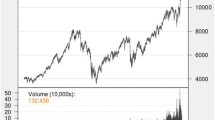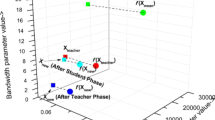Abstract
Support vector regression (SVR) has been successfully applied in various domains, including predicting the prices of different financial instruments like stocks, futures, options, and indices. Because of the wide variation in financial time-series data, instead of using only a single standard prediction technique like SVR, we propose a hybrid model called USELM-SVR. It is a combination of unsupervised extreme learning machine (US-ELM)-based clustering and SVR forecasting. We assessed the feasibility and effectiveness of this hybrid model using a case study, predicting the one-, two-, and three-day ahead closing values of the energy commodity futures index traded on the Multi Commodity Exchange in India. Our experimental results show that the USELM-SVR is viable and effective, and produces better forecasts than our benchmark models (standard SVR, a hybrid of SVR with self-organizing map (SOM) clustering, and a hybrid of SVR with k-means clustering). Moreover, the proposed USELM-SVR architecture is useful as an alternative model for prediction tasks when we require more accurate predictions.



Similar content being viewed by others
References
Adhikari R, Agarwal RK (2014) A combination of artificial neural network and random walk models for financial time series forecasting. Neural Comput Appl 24(6):1441–1449
Belkin M, Niyogi P (2003) Laplacian eigenmaps for spectral techniques for embedding and clustering. Neural Comput 15(6):1373–1396
Brabazon A, Keenan PB (2004) A hybrid genetic model for the prediction of corporate failure. Comput Manag Sci 1(3–4):293–310
Cao J, Lin Z (2015) Extreme learning machines on high dimensional and large data applications: a survey. Math Prob Eng 2015:1–12. doi:10.1155/2015/103796
Cao J, Zhao Y, Lai X, Ong MEH, Yin C, Koh ZX, Liu N (2015) Landmark recognition with sparse representation classification and extreme learning machine. J Frankl Inst 352(10):4528–4545. doi:10.1016/j.jfranklin.2015.07.002
Cao LJ, Tay FEH (2003) Support vector machine with adaptive parameters in financial time series forecasting. IEEE Trans Neural Netw 14(6):1506–1518
Che J (2014) A novel hybrid model for bi-objective short-term electric load forecasting. Int J Electr Power Energy Syst 61:259–266
Chen W-H, Shih J-Y, Wu S (2006) Comparison of support-vector machines and back propagation neural networks in forecasting the six major Asian stock markets. Int J Electr Financ 1(1):49–67
Chih-Chung C, Chin-Jen L (2011) LIBSVM: a library for support vector machines. ACM Trans Intell Syst Technol (TIST) 2(3):27. (Software available at http://www.csie.ntu.edu.tw/~jlin/libsvmLIBSVM)
Chih-Ming H (2013) A hybrid procedure with feature selection for resolving stock/futures price forecasting problems. Neural Comput Appl 22(3–4):651–671. doi:10.1007/s00521-011-07214
Diebold FX, Mariano RS (1995) Comparing predictive accuracy. J Bus Econ Stat 13:253–263. doi:10.1080/07350015.1995.10524599
Gestel TV, Suykens JAK, Baestaens DE, Lambrechts A, Lanckriet G, Vandaele B, Moor BD, Vandewalle J (2001) Financial time-series prediction using least squares support vector machines within the evidence framework. IEEE Trans Neural Netw 12(4):809–821
Huang CL, Tsai CY (2009) A hybrid SOFM-SVR with a filter-based feature selection for stock market forecasting. Expert Syst Appl 36(2):1529–1539. doi:10.1016/j.eswa.2007.11.062
Huang G, Song S, Gupta JND, Wu C (2014) Semi-supervised and unsupervised extreme learning machines. IEEE Trans Cybern 4(12):2405–2417. doi:10.1109/TCYB.2014.2307349
Huang G, Zhou H, Ding X, Zhang R (2012) Extreme learning machine for regression and multiclass classification. IEEE Trans Syst Man Cybern 42(2):513–529. doi:10.1109/TSMCB.2011.2168604
Huang G, Zhu Q, Siew C (2004) Extreme learning machines: a new learning scheme of feedforward neural networks. Proc Int Joint Conf Neural Netw 2:985–990
Hsu S-H, Hsieh JPA, Chih T-C, Hsu K-C (2009) A two-stage architecture for stock price forecasting by integrating self-organizing map and support vector regression. Expert Syst Appl 36(4):947–7951
Iosifidis A, Tefas A, Pitas I (2016) Graph embedded extreme learning machine. IEEE Trans Cybern 46(1):311–324. doi:10.1109/TCYB.2015.2401973
Keerthi SS (2002) Efficient tuning of SVM hyperparameters using radius/margin bound and iterative algorithms. IEEE Trans Neural Netw 13(5):1225–1229
Liu X, Gao C, Li P (2012) A comparative analysis of support vector machines and extreme learning machines. Neural Netw 33:58–66. doi:10.1016/j.neunet.2012.04.002
Li X, Xie H, Wang R, Cai Y, Cao J, Wang F, Min H, Deng X (2016) Empirical analysis: stock market prediction via extreme learning machine. Neural Comput Appl 27(1):67–78. doi:10.1007/s00521-014-1550-z
Lu CJ (2013) Hybridizing nonlinear independent component analysis and support vector regression with particle swarm optimization for stock index forecasting. Neural Comput Appl 23(7–8):2417–2427. doi:10.1007/s00521-012-1198-5
Nanda SR, Mahanty B, Tiwari MK (2010) Clustering Indian stock market data for portfolio management. Expert Syst Appl 37(12):8793–8798. doi:10.1016/j.eswa.2010.06.026
Niu XX, Suen CY (2012) A novel hybrid CNN-SVM classifier for recognizing handwritten digits. Pattern Recognit 45(4):1318–1325
Prakash J, Singh PK (2015) An effective multiobjective approach for hard partitional clustering. Memet Comput 7(2):93–104. doi:10.1007/s12293-014-0147-5
Pulido M, Melin P, Castillo O (2014) Particle swarm optimization of ensemble neural networks with fuzzy aggregation for time series prediction of the Mexican Stock Exchange. Inf Sci 280:188–204
Sheela KG, Deepa SN (2013) Neural network based hybrid computing model for wind speed prediction. Neurocomputing 122:425–429
Vapnik V (1995) The Nature of Statistical Learning Theory. Springer, NY
Venkatesh K, Ravi V, Prinzie A, Poel DVD (2014) Cash demand forecasting in ATMs by clustering and neural networks. Eur J Oper Res 232(2):383–392. doi:10.1016/j.ejor.2013.07.027
Acknowledgments
We would like to express our gratitude to the National Institute of Science and Technology (NIST), for the facilities and resources provided at the Data Science Laboratory at NIST to develop this study. The authors would also like to thank the editors and the anonymous reviewers for their innovative suggestions, which improved the quality of this manuscript.
Author information
Authors and Affiliations
Corresponding author
Ethics declarations
Conflict of interest
The authors declare that there are no conflicts of interest (either financial or non-financial) regarding the publication of the paper.
Appendix A: Technical indicators (features) used in this study
Appendix A: Technical indicators (features) used in this study
Formulas for technical indicators (features) | ||
|---|---|---|
Notation: i: i-th day [i days (\(i=1,2,\ldots ,N\)) counted from reference date, February 1, 2010] | ||
HP \(_{i}\): highest index value of i-th day | ||
LP \(_{i}\): lowest index value of i-th day | ||
OP \(_{i}\): open index value of i-th day | ||
CP \(_{i}\): closing index value of i-th day |
l Sl No. | Technical Indicator Name | Technical Indicator Description & Formula |
|---|---|---|
1 | 10-day moving average | The most current 10-day average closing value of the financial instrument. |
\(MA _{10,i} = \frac{\sum _{j=i-9}^i {CP_j } }{10}\) | ||
2 | 20-day bias | Closing value and the moving average value deviation for the past 20 days. |
\(BIAS _{20,i} = \frac{CP_{i } - MA _{20,i} }{MA _{20,i} } ,where MA _{20,i} = \frac{\sum _{j=i-19}^i {CP_j } }{20}\) | ||
3 | Moving average convergence/divergence (MACD) | MACD is the change between a 26-day and 12-day exponential moving average (EMA). ** |
\(\begin{array}{l} MACD _i = EMA _{12,i} -EMA _{26,i} ,where \\ EMA _{N,i } = (CP_i - EMA _{N,i-1} ) \times ( 2/ (N+1)) + EMA _{N,i-1} \\ \end{array}\) | ||
**EMA gives more weight to recent values and decreasing weight to older data. | ||
4 | Stochastic indicator %K | Stochastic %K a security’s closing value relative to its value range over a given period (9 days in this experiment). |
\(\% K_i = \frac{(CPi-LLP)}{(HHP-LLP)} \times 100,\) | ||
where LLP is the lowest low index value and HHP is the highest high index value over the last N periods. | ||
5 | Stochastic indicator %D | Moving average of %K (three-period simple moving average) |
\(\% D_i = \frac{\sum _{j=0}^2 { \% K_{i-j} } }{3}\) / | ||
6 | Stochastic slow %D | Moving average of %D (three-period simple moving average) |
\(\% SD_i = \frac{\sum _{j=0}^2 { \% D_{i-j} } }{3}\) | ||
7 | Larry William’s %R | Larry William’s %R is a momentum indicator that measures overbought/oversold levels (9 days in this experiment). |
\(\% R_i = \frac{(HP-CP_i )}{(HP-LP)} \times 100\) | ||
where LP is the lowest index value and HP is the highest index value over the last N periods. | ||
8 | Rate of change (ROC) | Ratio of current closing value to the value a certain number of periods (n periods) ago (10 days in this experiment). |
\(ROC_i = \frac{CP_i }{CP_{i-n} } \times 100\) | ||
where \({CP }_{i-n}\) is the closing index value of the (\(i-n\))-th day. | ||
9 | Relative strength index (RSI) | RSI is a momentum oscillator that compares the magnitude of recent gains to the magnitude of recent losses (we used a period of 5 days in this experiment). |
\(\begin{array}{l} RSI_i = \frac{AG_i }{AG_i +AL_i } \times 100, \\ where \\ G_i = \left\{ {\begin{array}{l} CP_{i-1} -CP_i , if CP_{i } >CP_{i-1} \\ 0 \\ \end{array}} \right. { and}\ L_i = \left\{ {\begin{array}{l} CP_{i-1} -CP_i , if CP_{i } <CP_{i-1} \\ 0 \\ \end{array}} \right. \\ AG_{i } = \frac{4}{5} \times AG_{i-1} + \frac{1}{5} \times G_i \ { and}\ AL_{i } = \frac{4}{5} \times AL_{i-1} + \frac{1}{5} \times L_i \\ \end{array}\) | ||
10 | Commodity channel index (CCI) | CCI measures the variation of a security’s value from its statistical mean (we used a period of 24 days in this experiment). |
\(\begin{array}{l} CCI_i = \frac{TP_i -MATP_i }{0.015 \times MD_i }, \\ where \\ TP_i = \frac{HP_i +LP_i +CP_i }{3} , MATP_i = \frac{\sum _{j=i-23}^i {TP_j } }{24}, MD_i = \frac{\sum _{j=i-23}^i {|TPj - MATPi|} }{24} \\ \end{array}\) | ||
where \(TP_{i}\) is the typical value for the i-th day, \(MATP_{i}\) is the 24-day simple moving average of the typical value for the i-th day, and MD\(_{i}\) is the 24-day mean deviation for the i-th day. | ||
11 | Psychological line | Psychological line is the volatility indicator based on the number of time intervals that the market was rising during the preceding period (13 days in this experiment). |
\(PSY_{i } = \frac{TDU_i }{13} \times 100~\% ,\) | ||
where \(TDU_{i}\) is the total number of days with regard to the rise in index value in the previous 13 days. | ||
12 | Buying/selling momentum indicator | Buying/selling momentum indicator (26 days) |
\(BSMI_i = \frac{\sum _{j=i-25}^i {(HP_j - OP_j )} }{\sum _{j=i-25}^i {(OP_j - LP_j )} }\) | ||
13 | Buying/selling willingness indicator | Buying/selling willingness indicator (26 days) |
\(BSWI_i = \frac{\sum _{j=i-25}^i {(HP_j - CP_{j-1} )} }{\sum _{j=i-25}^i {(CP_{j-1} - LP_j )} }\) | ||
14 | Momentum | Momentum measures the amount that a security’s value has changed over a given period (4 days) |
\(MO_i = CP_i -CP_{i-4} .\) | ||
15 | Disparity 5 | Measures the distance between the current value and the moving average over 5 days |
\(DIS_{5,i} = \frac{CP_i }{MA_{5,i} },\) | ||
where \(MA_{5,i }\) is the 5-day moving average for the i-th day. | ||
16 | Disparity 10 | Measures the distance between the current value and the moving average over 10 days |
\(DIS_{10,i} = \frac{CP_i }{MA_{10,i} },\) | ||
where \(MA_{10,i}\) is the 10-day moving average for the i-th day. | ||
17 | Moving average oscillators (MAO) | Value oscillator that displays the difference between two moving averages of different lengths (5 and 10 days) |
\(MAO_i = \frac{MA_{5,i} - MA_{10,i} }{MA_{5,i} },\) | ||
where \({MA}_{5,i}\) and \({MA}_{10,i}\) are the 5- and 10-day moving averages for the i-th day. |
Rights and permissions
About this article
Cite this article
Das, S.P., Padhy, S. Unsupervised extreme learning machine and support vector regression hybrid model for predicting energy commodity futures index. Memetic Comp. 9, 333–346 (2017). https://doi.org/10.1007/s12293-016-0191-4
Received:
Accepted:
Published:
Issue Date:
DOI: https://doi.org/10.1007/s12293-016-0191-4




